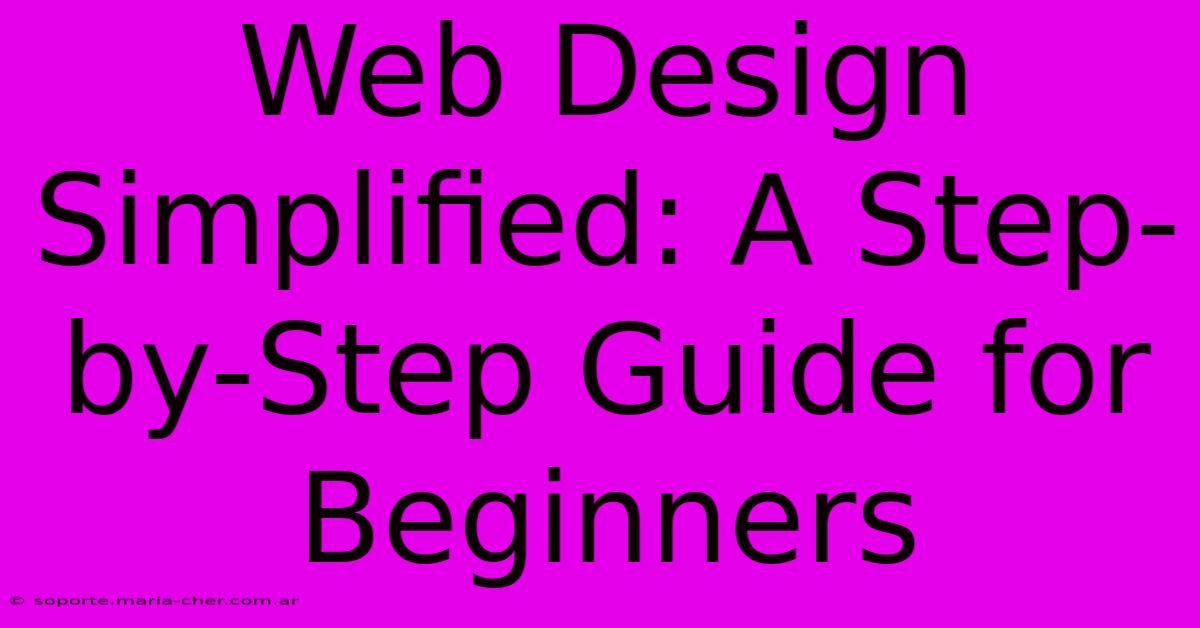Web Design Simplified: A Step-by-Step Guide For Beginners

Table of Contents
Web Design Simplified: A Step-by-Step Guide for Beginners
So, you're dreaming of crafting stunning websites but feel overwhelmed by the technical jargon and complex processes? Don't worry! This beginner-friendly guide breaks down web design into manageable steps, making the process enjoyable and achievable. Whether you're building a personal portfolio, a small business site, or just exploring your creative side, this guide will equip you with the fundamental knowledge you need to get started.
Understanding the Fundamentals of Web Design
Before diving into the nitty-gritty, let's establish a solid foundation. Web design isn't just about making things look pretty; it's about creating a user-friendly and engaging online experience. Here are some key concepts to grasp:
1. User Experience (UX) Design:
UX design focuses on how users interact with your website. A good UX ensures users can easily navigate your site, find what they're looking for, and accomplish their goals without frustration. Think intuitive menus, clear calls to action, and a logical site structure. Prioritizing UX is crucial for a successful website.
2. User Interface (UI) Design:
UI design deals with the visual aspects of your website – the look and feel. This includes typography, color palettes, imagery, and overall aesthetics. A well-designed UI complements the UX, making the website both functional and visually appealing.
3. Content is King:
No matter how beautiful your website looks, if the content is poor, users will leave. Ensure your content is relevant, engaging, and well-written. High-quality content keeps visitors interested and encourages them to stay longer.
Step-by-Step Guide to Web Design
Now, let's get our hands dirty and build a website! This guide outlines a simplified process, suitable for beginners:
Step 1: Planning and Research
Before writing a single line of code, plan your website thoroughly. Consider:
- Purpose: What is the primary goal of your website?
- Target Audience: Who are you trying to reach?
- Content Strategy: What information will you present?
- Competitor Analysis: What are other websites in your niche doing well?
Thorough planning saves time and effort in the long run.
Step 2: Choosing a Web Design Platform
There are several platforms to choose from, each with its pros and cons:
- Website Builders (e.g., Wix, Squarespace): User-friendly drag-and-drop interfaces, ideal for beginners. Limited customization options.
- Content Management Systems (CMS) (e.g., WordPress): Highly customizable and flexible, requires some technical knowledge. Offers extensive plugins and themes.
- Coding from Scratch: Requires advanced programming skills (HTML, CSS, JavaScript). Offers maximum control and customization.
Select a platform that aligns with your technical skills and project requirements.
Step 3: Designing Your Website
Once you've chosen your platform, it's time to design! Focus on:
- Layout and Structure: Create a clear and logical flow for your website's content.
- Color Palette: Choose colors that reflect your brand and appeal to your target audience.
- Typography: Select fonts that are easy to read and visually appealing.
- Imagery: Use high-quality images that enhance your website's visual appeal.
Remember to keep your design consistent and user-friendly.
Step 4: Creating Your Content
Develop engaging and informative content that aligns with your website's purpose and target audience. Optimize your content for search engines (SEO) by using relevant keywords naturally throughout your text.
Step 5: Testing and Launch
Before launching your website, thoroughly test it on different devices and browsers. Ensure all links work correctly, the site is responsive (adapts to different screen sizes), and the overall user experience is smooth. Once you're satisfied, launch your website and celebrate your achievement!
Beyond the Basics: Essential Web Design Tips
- Responsive Design: Ensure your website looks great on all devices (desktops, tablets, and smartphones).
- Search Engine Optimization (SEO): Optimize your website for search engines to improve its visibility.
- Accessibility: Make your website accessible to users with disabilities.
- Regular Updates: Keep your website's content and software updated.
Web design is an ongoing learning process. Embrace the journey, experiment with different techniques, and continuously improve your skills. With dedication and practice, you can create stunning and functional websites that achieve your goals!

Thank you for visiting our website wich cover about Web Design Simplified: A Step-by-Step Guide For Beginners. We hope the information provided has been useful to you. Feel free to contact us if you have any questions or need further assistance. See you next time and dont miss to bookmark.
Featured Posts
-
Coventry City Vs Leeds United 0 2
Feb 06, 2025
-
Wow Factor The Secret To Exceeding Customer Expectations
Feb 06, 2025
-
Unveiled The Secret To Ethical And Sustainable Fashion With Oeko Tex Mister Tee
Feb 06, 2025
-
Newcastle 2 0 Arsenal Carabao Cup Win
Feb 06, 2025
-
Greggs Iconic Menu Burger Rival
Feb 06, 2025
